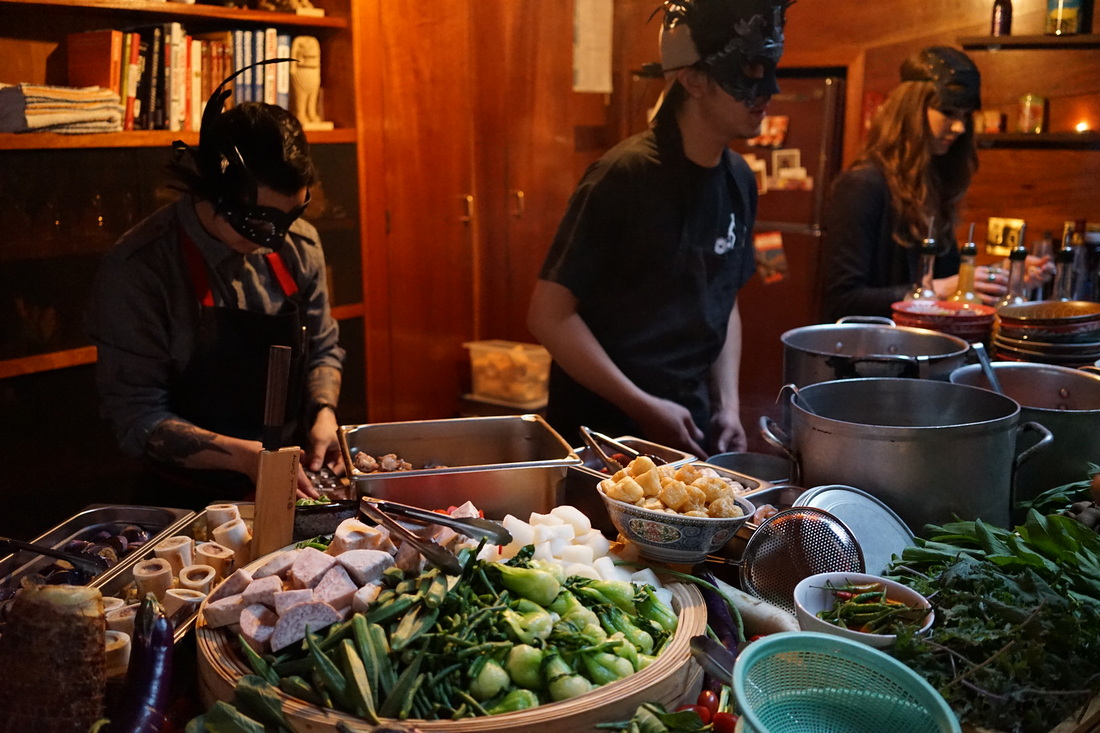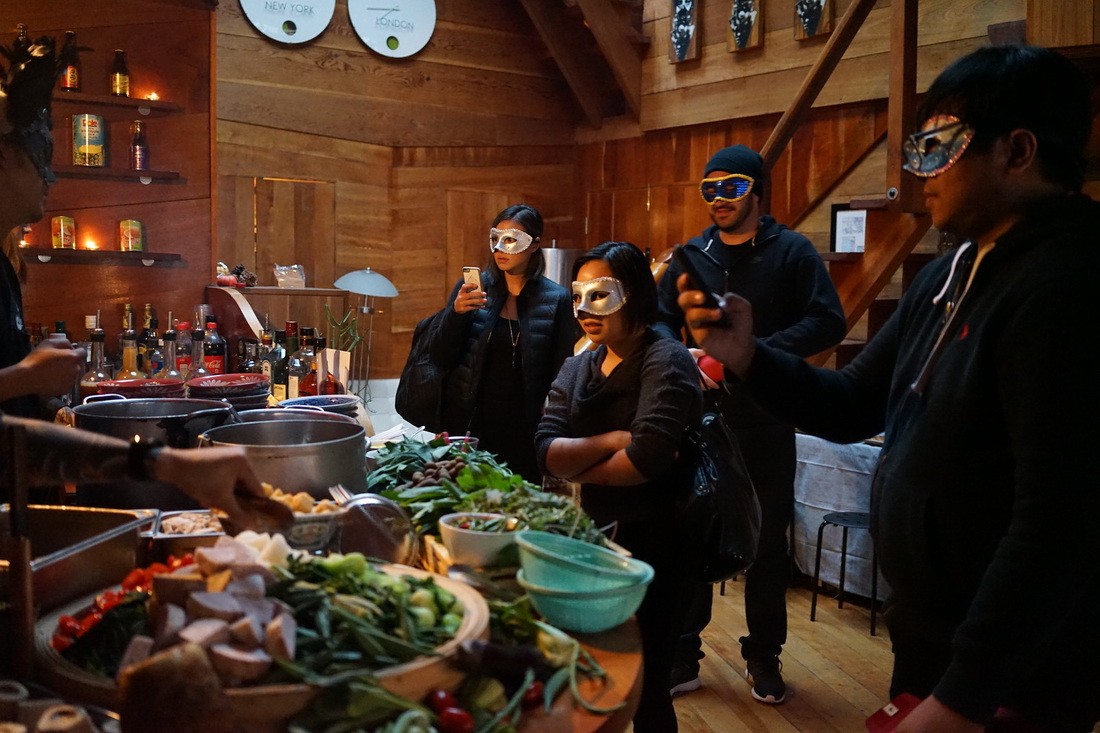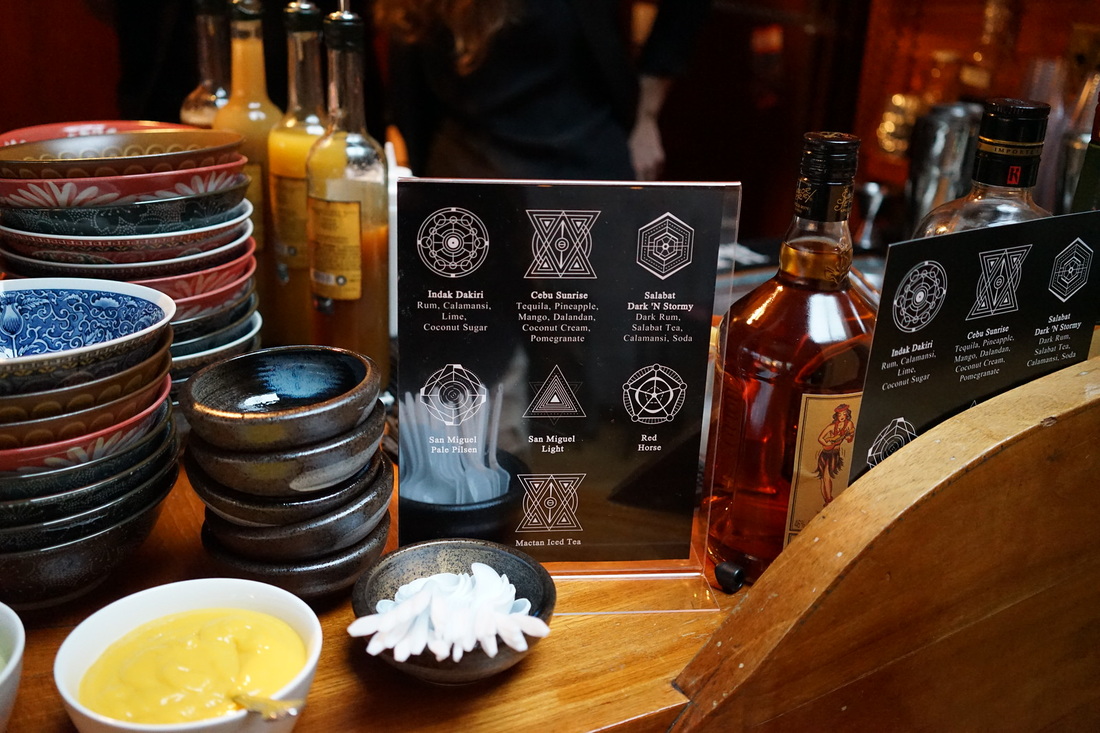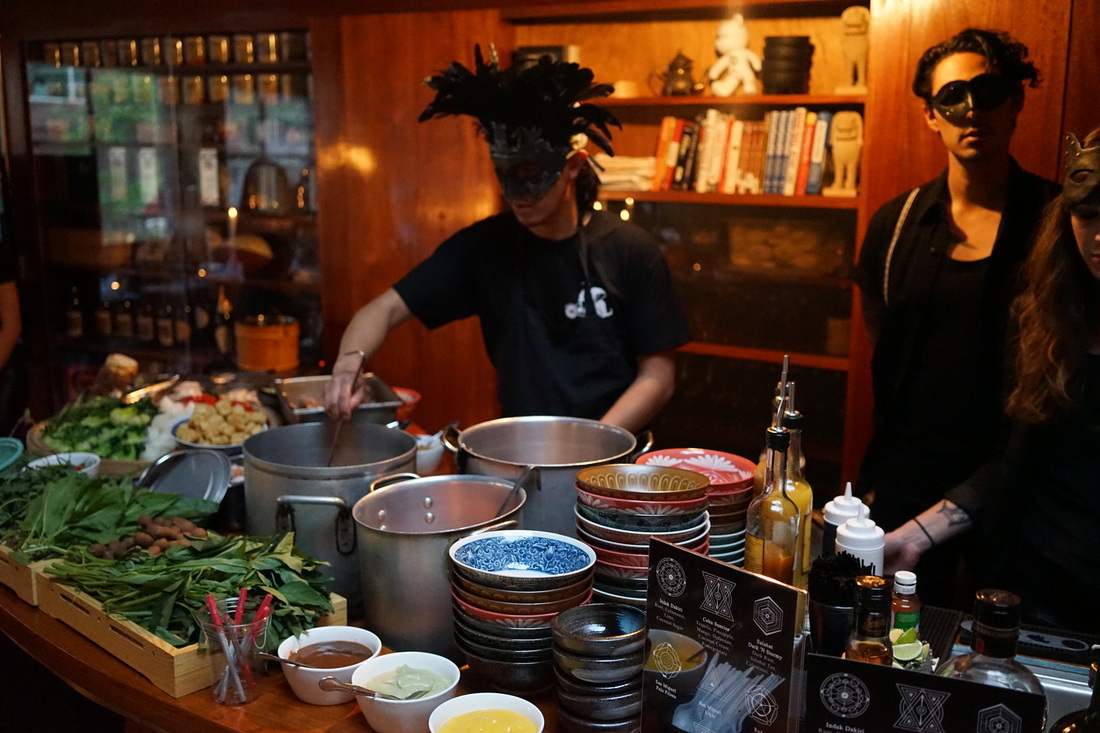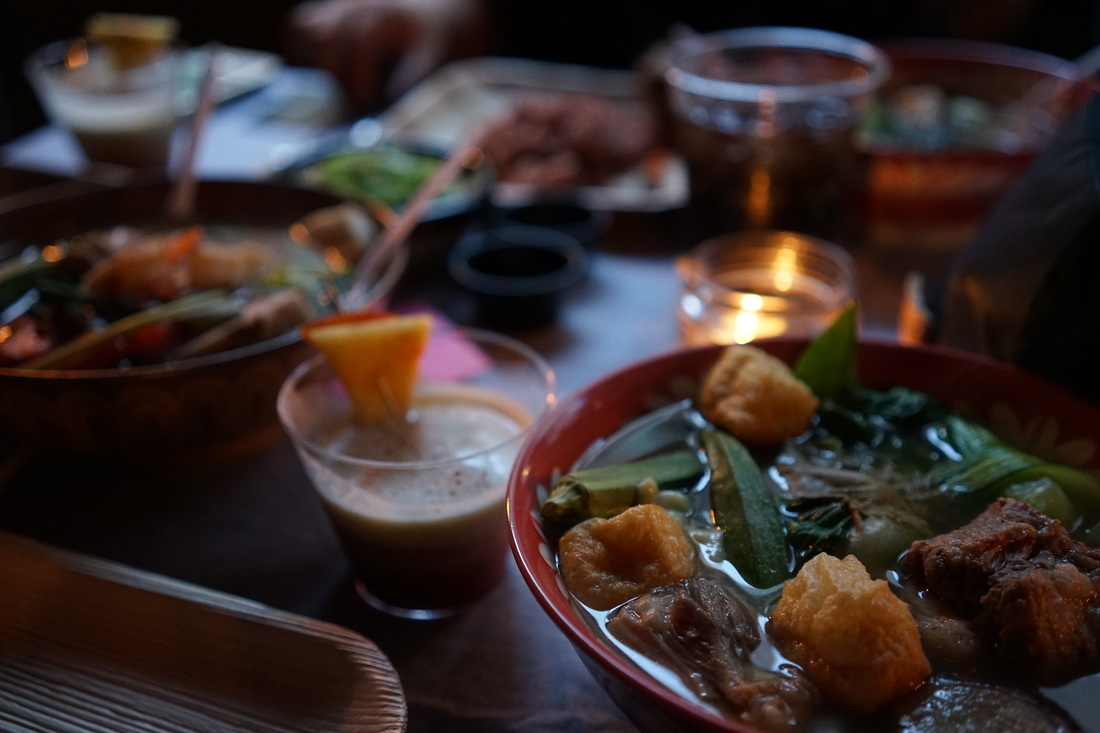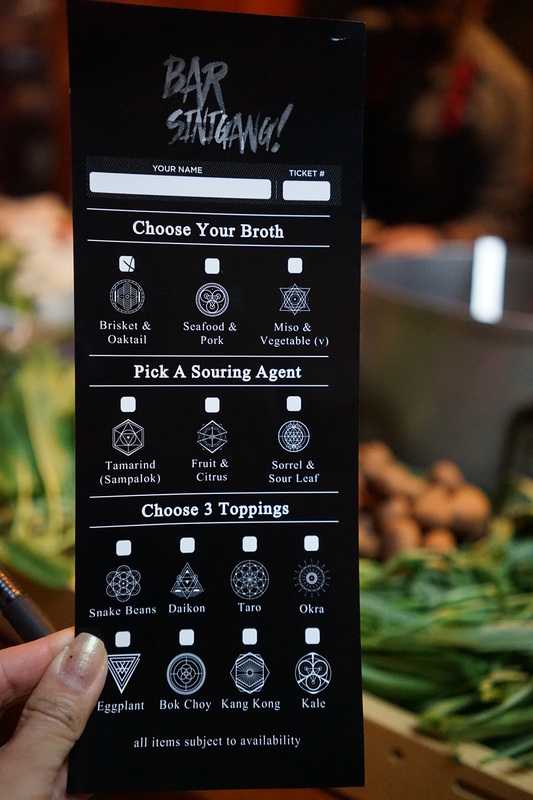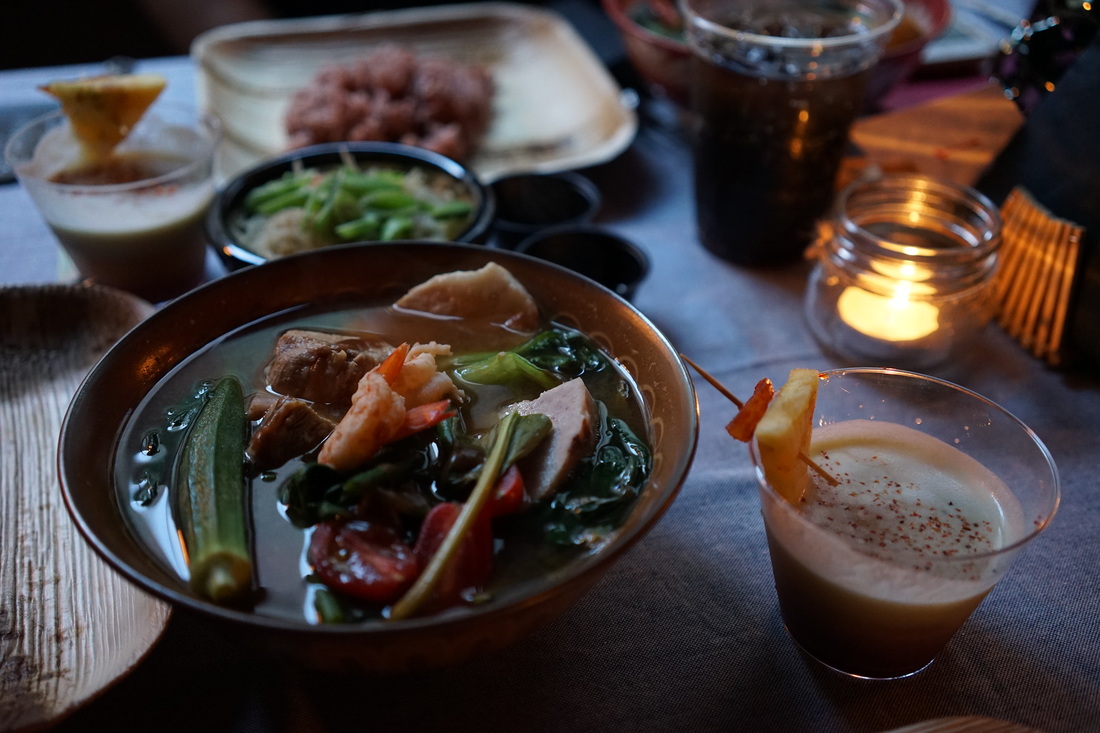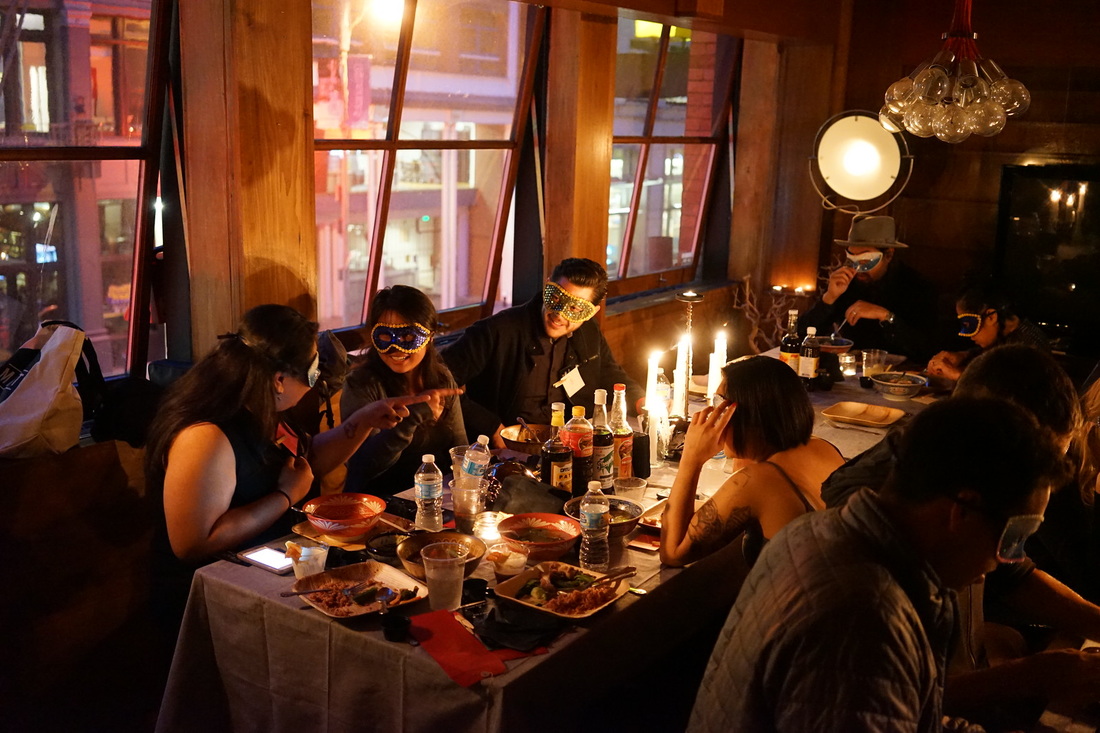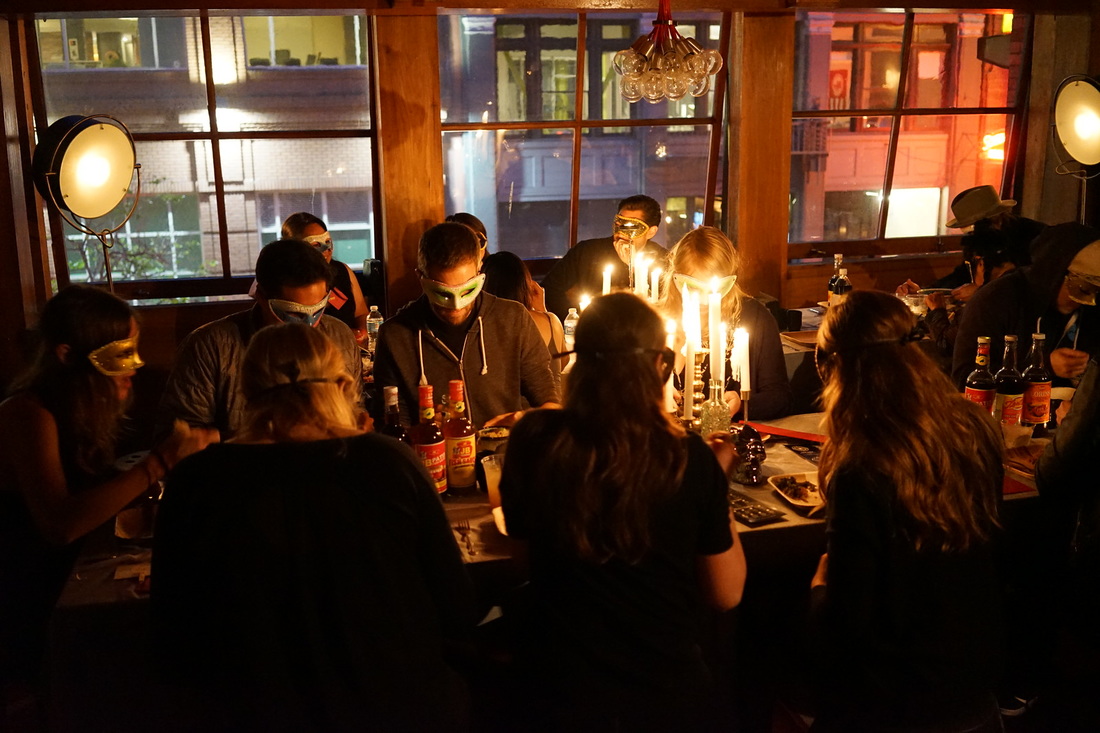Article By Kevin Pelgone ~ Photos by Candice Lo
Ushered through another door into a dimly lit room filled with masked individuals, we began to suspend our disbelief. The secret clubhouse / speakeasy style den was converted to feature communal tables adorned with candles, skulls, eccentric odds and ends, but most importantly, different styles of patis – fish sauce: a fermented, salty fish-based condiment used to flavor many Asian dishes, one being the Filipino sinigang. Funky yet mellow music played in the background as we made our way to the most important side of the room: the Sinigang Bar. The Sinigang Bar was immense. Several chefs and bartenders lined the back ready to take our custom order. A plethora of meats, seafood, and vegetables ranging from kangkong (water spinach) to taro were piled high in front of the broth station. We filled out our menus, ordered our special drinks, and patiently waited for our custom-made bowl of sinigang. I wondered to myself: if our bowls are so unique, how could we call all these variations ‘sinigang?’ To answer this question, I must first describe sinigang. For those uninitiated in Filipino cuisine, ‘sinigang’ is a stew made by combining a broth (typically a pork, beef, or seafood broth), a souring agent (tamarind, santol, kamias, sampaloc, guava, or sorrel - a new souring agent I discovered at Bar Sinigang), meats and/or seafood, and a wide variety of vegetables, served with a bed of pillowy rice. Filipinos typically enjoy this dish by adding chili peppers for heat and patis for another layer of salty goodness. Although served hot, its tartness gives it a pleasantly refreshing aftertaste. Was everyone eating a bowl that included the basic formula of broth, souring agent, meat/seafood, and vegetables? Check. Did everyone have it over rice and with some patis? Mostly check. Was everyone’s lip smacking from the broth’s umami? Check. Was everyone’s cheeks slightly contracting from its tartness? Yes, check. If everyone’s dish was ‘sinigang’ then there is no wrong version of ‘sinigang’ so long as it met the basic formula requirements of:
Let me close with a snippet of an anecdote from Chef Cocoy Ventura shared that evening by Filipino Food Movement’s chairman, P.J. Quesada, “Sinigang was born out of a storm. It was the result of Filipinos finding uprooted ingredients after a typhoon. Things like root vegetables, fish, and fruits washed ashore and made its way into the stockpot.” Born out of a storm, uprooted, making it’s way into a pot. Proud, gracious, and polite. Bar Sinigang, how typically Filipino.
2 Comments
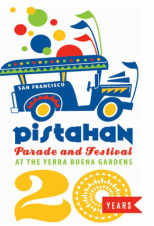 Join the Movement at Yerba Buena Park for the 20th Annual Pistahan Parade & Festival and celebrate our heritage, our food, and our future. One year ago at Pistahan 2012, a group of volunteers led by the Quesada family began to work toward the common goal of promoting Filipino Cuisine to expand awareness & engagement with Filipino Foodies. Pistahan, by the FAAE, is celebrating its 20th year with more than 75,000 people expected to attend. The Filipino Food Movement will be featuring an all-new exhibit on Filipino Cuisine at the Ramar Foods Culinary Pavilion located at the Waterfall Terrace. The Culinary Pavilion will be hosting several culinary contests and cooking demos by some of the Bay's most celebrated chefs. Sign Up for pavilion activities now! Culinary Pavilion Schedule Saturday, August 10 2013
Sunday, August 11 2013
|
- Home
- ABOUT
- FFM PASSPORT PROGRAM
- KULINARYA LIVE!
-
RECIPES
- Food for the Gods
- Ahi Ginataan
- Aligue Pasta
- Arroz Caldo
- Black Longganisa Paella
- Bibingka
- Atchara
- Banana Kunafa Cones in Malagos Chocolate
- Beer Braised Beef Shortrib Caldereta
- Bangus Sisig
- Pork Barbecue
- Beef Kilawin
- Bicol Express
- Black Sesame Penoy No Churn Ice Cream
- Bopis (Sizzling)
- Boudin Lumpia
- Bringhe Kapampangan
- Calamansi Curd & Lime Poppy Seed
- Chicken Adobo Pie with Homemade Banana Catsup
- Chicken Binakol
- Chicken ala King
- Chicken Relleno
- Crispy Pork SInigang
- Clam Sinigang
- Croquettas & Albondigas Con Patatas
- Ensaladang Talong (Eggplant Salad)
- Satori Cocktails
- Vegan Kare-Kare
- Ginataang Gulay
- Ginataang Manok, Kalabasa at Sitaw
- Grilled Cheese
- Halo-Halo
- Impossible Longganisa Ramen Burger
- Instant Pot Chicken Adobo
- Jackfruit Adobo Taco
- Kaldereta Nachos
- Kilawen Pulpo (Octopus Ceviche)
- Longganisa Balls
- Lumpia Burger
- Lumpiang Sariwa
- Mango Salsa
- Mango Salad
- Misua Almondigas
- Mit-chado
- Nilingta Ikan
- Tsokolate Financier
- Lamb Pancit with Handmade Noodles
- Pancit Palabok
- Pandan Crepe Cake
- Pol Pog
- Polvoron
- Pork Belly Sisig
- Pork Tenderloin Adobo with Banana Ketchup, Potatoes and Jalapeño Pepper
- Sinigang Na Salmon sa Miso
- Sinilihan aka Ginataang Kalabasa at Hipon
- Shrimp Sinigang
- Filipino Spaghetti
- Steak Salpicao Sizzler
- Filipino Tacos
- Spiced Heritage Carrots
- Ube Pudding
- Ube White Chocolate Chip Macadamia Coolies
- Ube Whoopie Pie
- Vegan Crispy Bicol Express
- Side of Zuke (Zucchini Rice)
- GLOBAL RESTAURANT DIRECTORY
- BLOG
- SAVOR FILIPINO SUMMIT
- PRESS
- VOLUNTEER
- Product
- Pork (Baboy)
- New Page
|
The Filipino Food Movement® name and illustrations are the copyrighted work of the Filipino Food Movement® a 501(c)3 public not-for-profit corporation for public benefit. Federal Tax ID No. 47-1292926 All Rights Reserved.
We are an all-volunteer organization. Funds from our sponsors, sales of merchandise, and participation in events enable us to make a sustainable impact on the Filipino Culinary Arts industry. 1101 Railroad Lane, Pittsburg, CA 94565 | 2740 38th Avenue, San Francisco, CA 94116 | [email protected] |

